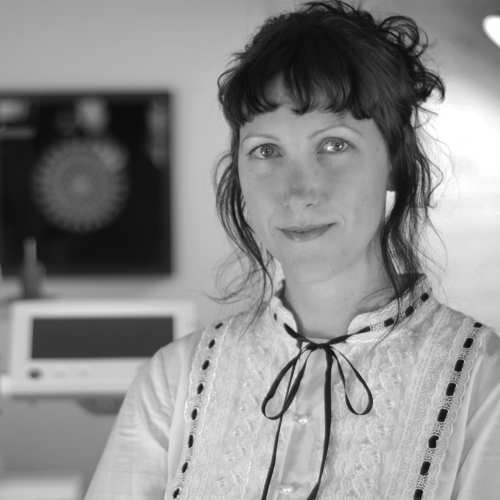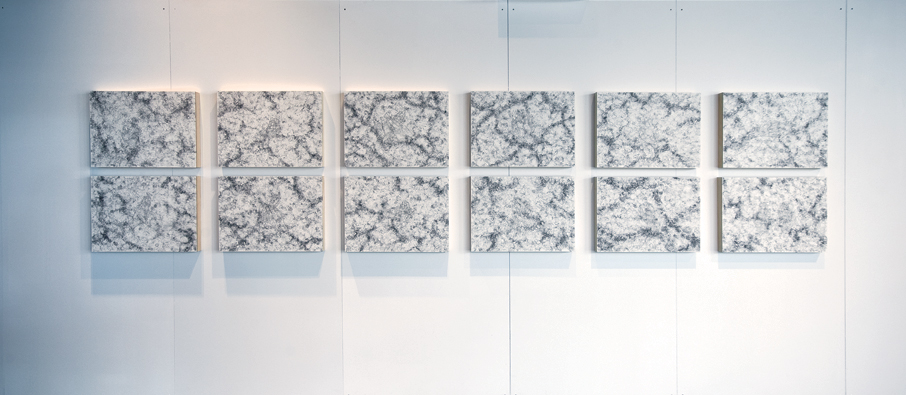 A New York-based mixed-media artist, Laura Splan uses microbiological, anatomical, and medical images as points of departure to explore perception of the body and linkages between art and science. Her conceptually driven work employs a variety of materials and processes that usually have a feminine sensibility about them. She often combines scientific images and materials with more domestic or familiar ones, such as the ornamentation of wallpaper or the design of a doily. Unsettling, biomedical imagery is foiled by more comfortable domestic imagery and craft processes. Likewise, the seemingly familiar and benign are subverted by the anatomical and biological. She often uses her own body in the production of materials for her work.
A New York-based mixed-media artist, Laura Splan uses microbiological, anatomical, and medical images as points of departure to explore perception of the body and linkages between art and science. Her conceptually driven work employs a variety of materials and processes that usually have a feminine sensibility about them. She often combines scientific images and materials with more domestic or familiar ones, such as the ornamentation of wallpaper or the design of a doily. Unsettling, biomedical imagery is foiled by more comfortable domestic imagery and craft processes. Likewise, the seemingly familiar and benign are subverted by the anatomical and biological. She often uses her own body in the production of materials for her work.
For Watching Hands, Splan responded to the background materials about handwashing provided by CDC and to the opportunity to use Georgia-Pacific Professional product as art material—both providing conceptual constructs for her final project titled Surface Tension. According to the artist, Splan’s series of paintings allude to the invisible worlds that are at play as we wash our hands. Drawings of hands and microbes underlie a latent image of bubbles rendered in foam hand soap. Each of the twelve paintings depicts hands in a different position of proper handwashing as recommended by the World Health Organization (WHO). Renderings inspired by bacterial and viral microbes surround the hands. Using soap provided by Georgia-Pacific Professional, Splan playfully creates a unique patina for the series by using the foam soap as a wet media. When applied to powdered graphite, the soap bubbles distribute the graphite in and around their own shapes. Once dried, the spherical shape of each bubble is rendered in the graphite and soap residue. In other words, the use of the soap as an artistic medium adds yet another formal dimension to the work, while at the same time underscoring its content.
The WHO poster that serves as source for Splan’s Surface Tension targets healthcare workers, and is meant for global distribution. It has been well-documented that the spread of potentially fatal infections in hospitals from patient to patient and from patient to healthcare worker and vice-versa can be prevented through proper handwashing. By definition, the How to Handwash poster didactically instructs the 12 steps necessary to clean hands so that they are “safe.” But, as Splan has noted, both the drawings and the language used in the poster are quite intimate and poetic. For instance, the instructions to “rub hands” in a “palm to palm” fashion, in addition to being an important step in handwashing, can also connote emotional states, such as nervousness, or suggest prayer gestures used in rituals. In drawing upon the WHO poster illustrations as a departure point, Splan focuses on only the hands, eliminating details such as a sink or towels, thus enhancing this sense of intimacy.
Splan is trained as a biologist, as well as an artist. Her interpretive microbes floating on the clayboard surfaces of Surface Tension are based on actual viruses and bacteria, such as the H1N1 influenza virus, rhinovirus and Salmonella—all of which can be transmitted by not washing one’s hands. On one level, she is quite literal as she makes the connection between hand hygiene and disease transmittal. Simultaneously, she is drawn to the microscopic world as formal design elements, and notes that microbial images are frequently appropriated into contemporary life and culture.